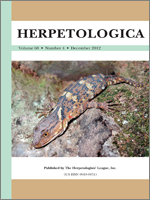Terrestrial amphibians may dehydrate when exposed to low humidity, representing an important factor affecting spatial distribution and community composition. In this study we investigated whether rates of dehydration and rehydration are able to explain the spatial distribution of an anuran community in a Restinga environment at the northern coast of the State of Bahia, Brazil, represented by 11 species distributed in 27 sample units. The environmental data set containing 20 variables was reduced to a few synthetic axes by principal component analysis (PCA). Physiological variables measured were rates of dehydration, rehydration from water, and rehydration from a neutral substrate. Multiple regression analyses were used to test the null hypothesis of no association between the environmental data set (synthetic axes of PCA) and each axis representative of a physiological variable, which was rejected (P < 0.001). Of 15 possible partial regressions only rehydration rate from neutral substrate vs. PC1 and PC2, rehydration rate from water vs. PC1, and dehydration rate vs. PC2 were significant. Our analysis was influenced by a gradient between two different groups of sample units: a beach area with high density of bromeliads and an environment without bodies of water with low density of bromeliads. Species of very specific natural history and morphological characters occur in these environments: Phyllodytes melanomystax and Scinax auratus, species frequently occurring in terrestrial bromeliads, and Ischnocnema paulodutrai, common along the northern coast of Bahia and usually found in forest remnants within environments with low number of bodies of water. In dry environments species with lower rates of dehydration were dominant, whereas species showing greater rates of dehydration were found predominantly in microhabitats with greater moisture or abundance of bodies of water.
How to translate text using browser tools
1 December 2012
Water Balance and Spatial Distribution of an Anuran Community from Brazil
Lucianne Dabés,
Vanessa Maria Gomes Bonfim,
Marcelo Felgueiras Napoli,
Wilfried Klein
ACCESS THE FULL ARTICLE

Herpetologica
Vol. 68 • No. 4
December 2012
Vol. 68 • No. 4
December 2012
Amphibia
Dehydration
evaporative water loss
habitat
rehydration
water absorption
Water balance




